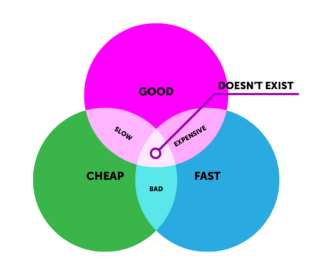Measuring the value of design.
by Jon Fukuda
“How do I know I’ll get a return on investment in user experience (UX) and design?” How can I justify the cost?” These are the two most frequently asked questions by information management system product teams.
Articulating what can seem invisible and intangible to stakeholders on the threshold of an investment decision in design is challenging. That’s why numerous research studies and reports have been conducted to demonstrate the business impact and value of design:
- McKinsey’s recent “The Business Value of Design” report, which described a 10% revenue growth and 20% shareholder return advantage for businesses in the top quartile of design-centric maturity.
- Invision’s “The New Design Frontier,” a 40-page research report analyzed the state of design maturity across 24 industries, 77 countries, and 2,200 companies. The results of this 2019 study found that design propels substantial business impact. Companies with high design maturity are more likely to see cost savings, revenue gains, productivity gains, speed to market, and brand and market position improvements through their design efforts.
- The Design Management Institute’s 2016 study that quantifies what design professionals suspected for years: over a ten year period design-driven companies outperformed the Standard & Poor’s 500 by 211%.
- The Danish Design Center’s 2001 “Design Ladder” describing the ways businesses incorporated design. By 2003, they used the model to establish that companies with the highest integration of design increased their financial performance by 20% compared to businesses where design integration remained static or declined.
Yes, an investment in design is expensive.
It’s not enough to hire one UX or design resource to support entire software project teams. The field of Design and UX is diverse and spans strategic research and analysis, requirements management, content strategy, information architecture, solution architecture, interaction modeling and design, visual design, user interface (UI) development, quality assurance, and more.
You can hire these resources and pay the annual salary base of $70k – $120k for 3-7 practitioners, with the added investment of business process re-engineering to incorporate them into your business model – a $.5M – $1M investment annually. An in-house team can support projects on a rolling basis, and also contribute to the design management infrastructure that leads to an internal design management system – reusable assets, single source of truth concerning users, features, functions, and design specifications.
At Limina, we’ve developed a model to perform the full spectrum of services: research, strategy, requirements management, systems/solution definition, design, evaluation, and design management. When we end our engagements, our clients are armed with the product specification, design, implementation, success metrics, and design system for managing enhancements. Our discovery process is an exercise in risk mitigation and narrowing the cone of uncertainty. Our requirements management and design process allow the lowest level of effort needed to deliver the Minimum Lovable Product. It is a carefully honed process of designing enough to articulate the optimum UX through high-value features, with room to incrementally enhance product features and add functionality without redesigning the whole system.

Some prospective clients will experience sticker shock on the front end of a sales discussion with our team – we see it over and over again. There’s ample reason for this. Cheap, easy, and fast don’t exist together in design any more than other aspects of product development, expressed more clearly in this giphy..
When someone is hell-bent on this path, they can find their way to it… there is everything from building a WordPress or Squarespace site with a UI template kit, to independent designers willing to work sweat-equity deals. Rarely will these roads lead to a sustainable design system that will contribute to the strategic growth of the business.
What’s the ROI of UX?
Customers who have been bitten by overly-optimistic cost expectations, or who are savvy enough to understand the costs associated with the rigors of design, will take the leap and realize the return on their investment. The key performance indicators (KPIs) might show a reduction in customer support, increased user conversion and retention, or startup investments, acquisitions, and exits. All of these would have been planned for, designed to measure, and optimized for business impact and empathy for the UX. In a Limina blog post, we shared a short list of additional KPI’s where UX investments add value. We’re sharing them again in this post.
Small, incremental, UX activities in the early phases of project conceptualization become hugely beneficial in the long run. A report from Forrester, “Customer Experience Index Ranking and Watermark Consulting,” indicates that every $1 invested in UX brings $100 in return.
Sometimes a blog post isn’t enough – design disruption, whether you know how to embrace and incorporate it or not, is happening all around us. Listen to design directors at leading services, and product firms talk about how design-driven innovation paved the way for market disruption in Invision’s film, Design Disruptors.
Design-led firms have design representation in the C-Suite, they integrate design with cross-functional teams, they practice continuous iteration, and they embrace a user-centered design methodology as tracked in the McKinsey study. I’d love to hear how you’ve taken a design-driven approach to drive innovation in your business – or talk about how you could be doing it better. Drop me a line!